Clik here to view.
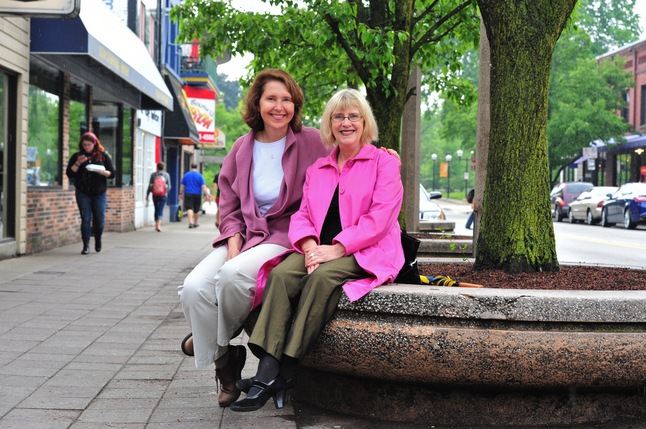
Ann Arbor DDA Executive Director Susan Pollay, left, sits with Maggie Ladd, executive director of the South University Area Association, on one of the tree planters along South University Avenue. They want to get rid of them.
Ryan J. Stanton | AnnArbor.com
But what might have been good urban design in the late 1980s doesn't work well anymore, said Susan Pollay, executive director of the Ann Arbor Downtown Development Authority.
The DDA is thinking it might be time to get rid of those planters — and replace them with much smaller ones — as it looks to give South U a makeover.
Clik here to view.
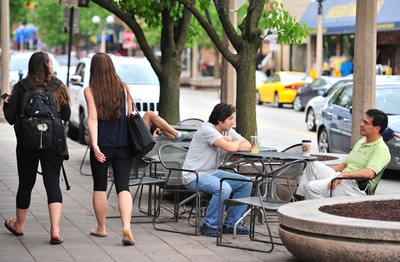
One of the hopes is that removing the planters will create more space for restaurants and coffee shops to be able to offer outdoor seating along South U.
Ryan J. Stanton | AnnArbor.com
"It's probably one of the most compelling, simply because of the street activity we're not getting because of the trees," she said, suggesting the planters take up too much space on the sidewalks and stand in the way of businesses being able to offer more outdoor seating for customers.
"With the more people we're adding to this neighborhood who are living here as residents, that's one of the elements that we need to be thinking about," Pollay said, "because the overall vitality is coming back, and what can we do to help?"
Maggie Ladd, executive director of the South University Area Association, agrees that getting rid of the planters and giving South U a makeover is needed.
"This streetscape is very old and tired now," she said. "The reason we need to redo the streetscape is because the infrastructure is failing."
Ladd said the trees that were planted years ago have overgrown their planters, and in some cases their roots are now causing the brick pavers around them to heave.
"We just have mulch in the planters and that's because we can't plant anything because the roots have taken everything up," she said.
Clik here to view.
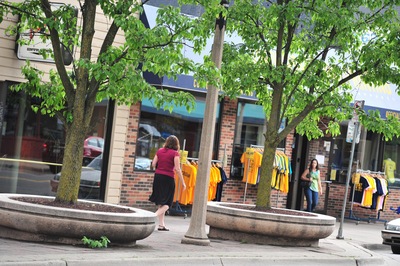
Pollay said it's inevitable that the DDA will have to do something about South U with the trees having overgrown the planters and the infrastructure starting to fail.
Ryan J. Stanton | AnnArbor.com
"I think it would take away from South U," he said. "It's a staple for the city of Ann Arbor. It's tree city — Tree Town."
Mary Holt, a recent University of Michigan graduate, said she mostly comes to South U to go to Pizza House. She said she wouldn't mind trading the planters for more outdoor seating at restaurants.
"They look nice, but I don't have an extreme attachment to them," she said. "I think more outdoor seating is always good."
While the planters have become characteristic of South U, Ladd said, it's not a good characteristic. People leave their cigarette butts in them, some people sleep in them, and dogs even jump up to go to the bathroom in them, she said, "so they're not ideal."
'It's the comeback period'
Ladd believes the timing is right for a change as more and more people are calling South U home with new high-rise developments going in — mostly student apartments at this point.
Clik here to view.
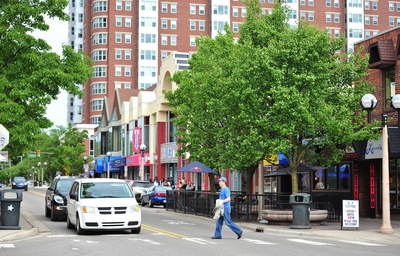
The Landmark high-rise apartment building, visible in the background, is one of multiple developments changing the South U skyline.
Ryan J. Stanton | AnnArbor.com
"We have a similar zoning to the rest of downtown now," she said. "You can see there are different projects coming online. And there are a few more in the pipeline I think, so we're really in a very exciting time for this area. It's the comeback period."
In 2006, new zoning encouraging high-density commercial and residential development was adopted to reinvigorate South U. Within months, the city approved a 10-story apartment building known as Zaragon Place to replace the historic 1923 Anberay Apartments on East University.
The nearly 250 beds Zaragon brought has helped fuel what Ladd describes as a comeback for South U. The area welcomed another 600-plus beds last year with the 14-story Landmark high-rise, and another 14-story high-rise approved above Pizza House promises at least 175 more beds.
"If you put another 1,000 people down here, you're going to see the difference," Ladd said, tallying up the bed count for those new developments.
Most of South U is now zoned to allow buildings up to 150 feet tall. Ladd said it's difficult to predict the market, but she sees a lot of potential for more dense development.
"Which is good," she said. "Before we changed the zoning, it was all one- and two-story buildings. You couldn't do anything else. Sometimes you couldn't do more than one if you had a basement — they counted that. It was so restrictive that we couldn't get anything done down here."
Asked where the next high-rise might go on South U, Ladd said there's definitely strong interest in some properties, but she's not able to discuss that.
Starting the process
The DDA has funded a number of major streetscape projects in the downtown over the years from Liberty Street to Fourth Avenue, and more recently Fifth Avenue and Division Street.
Clik here to view.
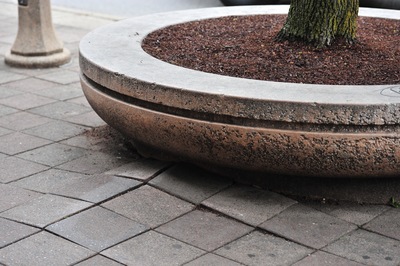
Ladd said the trees that were planted years ago have overgrown their planters, and in some cases their roots are now causing the brick pavers around them to heave.
Ryan J. Stanton | AnnArbor.com
Pollay said the DDA hasn't priced any of the work yet, but she guesses it could be in the $1 million to $2 million range if infrastructure like water mains and fire hydrants are addressed.
Pollay said DDA officials also might need to talk with DTE Energy about electrical capacity on South U to make sure there's enough to meet future needs. Ladd also raised concerns about water pressure.
"There isn't enough pressure to allow us to water plants, which is bothersome to me," she said. "It makes me wonder is there enough water pressure if there was an emergency?"
Ladd and Pollay both suggested it might make sense to draw inspiration from State Street when it comes to the kind of tree planters that could replace the ones on South U — something less overpowering, yet still enough to support trees along the street.
Pollay said they also need to be thinking about trash and recycling receptacles, and the number of bike hoops along the street.
"One of the elements we haven't figured out yet is we want seating for people who may not want to be at a cafe — they may just want to be talking to a friend," she added.
Clik here to view.
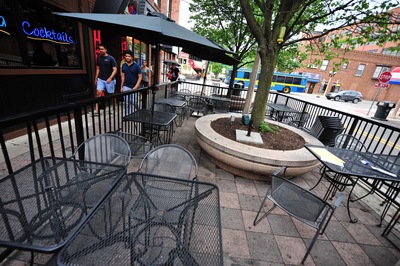
The Brown Jug bar and restaurant on South U has worked around the planters to provide outdoor seating for its customers.
Ryan J. Stanton | AnnArbor.com
"We think that's where reinvesting in it gives the overall message that people care, this is a neighborhood, we believe in our future," she said.
In some cases where brick pavers around the planters have cracked, Pollay noted, they've been filled in with cold patch.
"Increasingly you're going to start to see more and more cold patch, because we don't have replacement pavers," Pollay said. "It's only going to get worse, so now is a good time to start thinking about what to do to take the place of the pavers ... and what kind of sidewalk does work well."
Pollay said she loves the large trees along South U just like everybody else, but it's only a matter of time before they go, so now is a good time to start talking about what to do.
"Streetscapes in our town take years to go through a design process, an approval process and finally an installation process, so what we're saying is it's time to begin the design process," she said.
The changing face of South U
Ladd has been observing the changes on South U for decades. She and her ex-husband owned and operated a jewelry store on South U from about 1982 to 2005.
Clik here to view.
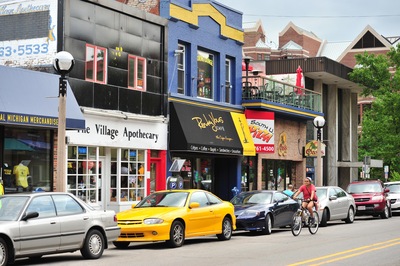
Ladd acknowledges South U has become a largely student-centric corridor with many bars and restaurants that cater to a college crowd. But as new development occurs, she said, there's room for new businesses, and she thinks there's a market for more diversity.
Ryan J. Stanton | AnnArbor.com
Ladd said the revitalization process started in the late 1990s, just prior to the DDA building an 854-space parking garage on Forest Avenue.
"We had a dilapidated parking structure that was literally being condemned floor by floor," she said. "Businesses were fleeing because they couldn't bring their customers in."
Ladd said it wasn't until around 2003 that they finally realized zoning was the problem.
She acknowledges South U has become a largely student-centric corridor with many bars and restaurants that cater to a college crowd. But as new development occurs, she said, there's room for new businesses, and she thinks there's a market for more diversity.
"Not just diversity of housing, but diversity of businesses," she said. "And we think one will follow the other with new business spaces being available in the bottom of these new buildings."
Ladd said her experience on South U in the 1980s was that it was more of a "university area," as opposed to a "student area."
"It was a real downtown area with all sorts of retail shops, galleries, a variety of restaurants, a variety of service businesses," she said. "There was a movie theater down here, a gas station.
"You could come and get your shoes fixed. It was very much the downtown area for the residents from around here."
Clik here to view.
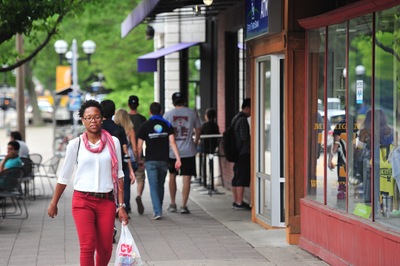
Ladd said it's "very impactful" for businesses to have hundreds of new residents walking up and down South U every day to get where they need to go.
Ryan J. Stanton | AnnArbor.com
"We have Middle Earth now, and that's the only business that's left from that era," she said.
Over the years, Ladd said, bad decisions were made at vital points that hurt South U.
"I mean, when you put a Burger King, a McDonald's and a Taco Bell in one block, you've changed the look of the area, the feel of the area, the people who visit the area," she said, adding those kinds of changes contributed to the decline of South U in the 1990s.
But she believes South U is coming back. And she points to boutiques like Motivation and YCI Clothing and Launch as examples of its diversity.
"I'm looking at this street and you've got one-of-a-kind owner-occupied restaurants and retail again," Pollay added. "I didn't see this 10 years ago."
Ladd said it's been "very impactful" to have hundreds of new residents walking up and down South U every day to get where they need to go.
"Businesses here survived this last year while East Quad was closed. They maintained their business levels, and we think it's because of the people living down here," she said. "So this coming school year we're expecting to see a rise in profitability of the businesses because East Quad will be open."
Ryan J. Stanton covers government and politics for AnnArbor.com. Reach him at ryanstanton@annarbor.com or 734-623-2529. You also can follow him on Twitter or subscribe to AnnArbor.com's email newsletters.